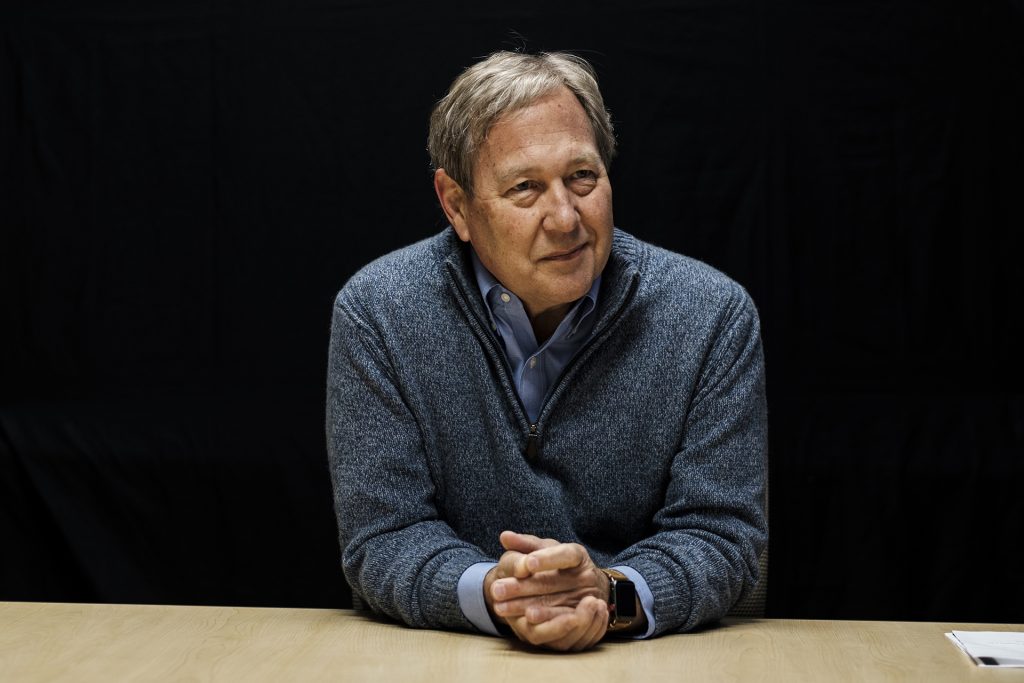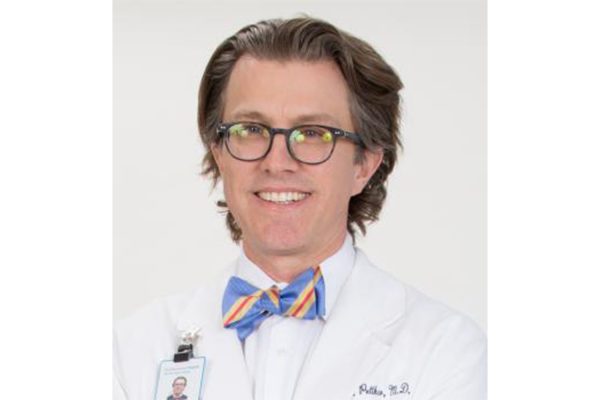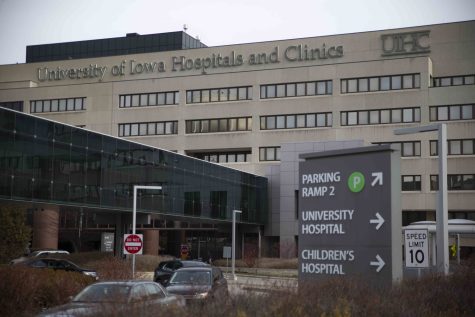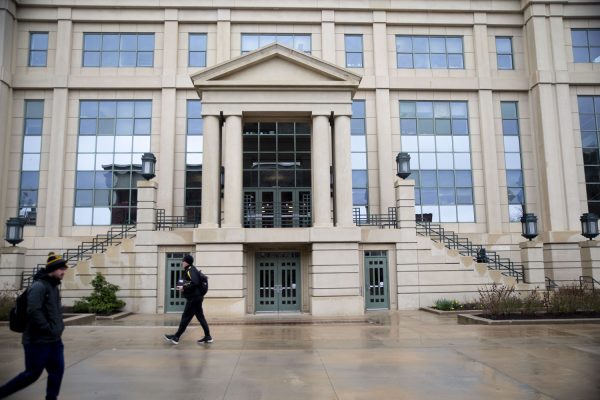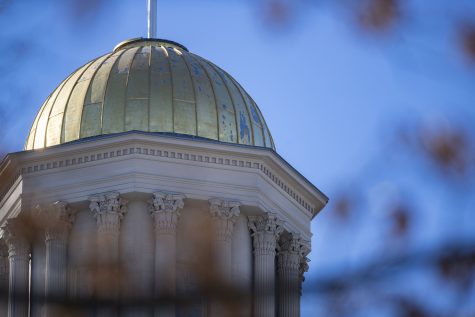Q&A: UI president talks tuition, alcohol, sexual assault
The Daily Iowan sat down with University of Iowa President Bruce Harreld to discuss some issues and topics relevant to the UI this semester.
Bruce Harreld answers questions during an interview at the Adler Journalism Building on Dec. 7, 2017. The interview covered topics including tuition, alcohol in the greek community, and financial aid. (Nick Rohlman/The Daily Iowan)
December 11, 2017
DI: The moratorium on alcohol in greek events has been scaled back a little bit this week with a pilot program that allowed select chapters to [have alcohol at social events]. Given that this moratorium has gone on the entire semester, how do you think that’s affected the alcohol culture in greek communities and accomplished the goal of reducing harm?
RELATED: UI Greek community to test out new pilot program for alcohol at events
Harreld: I think it’s helped. I think many have been much more responsible. If nothing else, we’ve had a really good conversation about it. I think I’ve said to many members of the greek community, parents don’t send their students here to not come home, and we had a very unfortunate event last [spring], and it caused us to pause and say, “How can we do better?” So I’ve been a big fan of pausing here and thinking about the role of alcohol, drugs, and just actually life on our campus, so I think it’s been a useful moment.
DI: I’ve heard some talk with multicultural-programs staff about establishing a multicultural center so students don’t have to choose, “I just identify with this center or that center.” What are your thoughts on this as a possibility?
RELATED: Students find home away from home thanks to UI cultural center coordinators
Harreld: Let me tell you what I do know and tell you what we’re working on. We’re one of the first campuses in the United States to have cultural centers, we have a long tradition of that. Several of them are over on the West Side of campus. We’ve done a fair amount of reinvesting in each of them … We’ve asked the question of where we go longer term, because I think there are other groups that are thinking about forming houses and the like, so we’ve been talking about that alley if you will, I think it’s Grand Avenue, it’s a small avenue by Melrose and Slater House. You know where the LGBT house is? It’s right by that, and there’s an environmental house on the other side; it’s a pretty small alley.
We talked about, we now own that, it used to be part of the city, we talked about closing that off and building what we’d call a cultural corridor, making a walking zone, putting restaurants in there, lighting it up, it’s a long-term plan, but in the process of doing that taking one of the houses or building another house. None of the existing houses have enough [room] for a social evening. All the kitchens are pretty small, all the rooms are pretty small … so you can get maybe 25, 30 people, but if you wanted to have an event on a weekend for 120 people, you couldn’t do it, so we were thinking about building a common house, a common kitchen in one of those facilities to do that. I have not heard, when you said a multicultural center, I haven’t heard of that, maybe that’s what people were referring to is that center, and yes, the rough plans to do that. I think like all things here in university life these days is where is the funding? How long will it take?
We’ve worked with UISG on getting their thoughts on what would work with the existing cultural houses, or what the community thinking about the need for a cultural house, and I think they all endorse this idea of blocking that off to traffic, paving it with walking stone, making it a second Ped Mall, a mini Ped Mall, and I think everyone likes that idea a lot, and I think we’re in the process of trying to raise money, donations, clawing back anything we can find from the rest of the budget to make that happen. And I think think that’s a good idea, I really do, I think at the end of the day whatever we can do to make students feel more comfortable when they’re not in class and identify with groups that they want to hang out with. By the way, there’s nothing wrong, and I think we do have people that identify with a couple of these houses, we don’t have any rules that say that you need only to identify with one group. Most of us identify with multiple groups.
DI: About the $12 million in appropriations that has been requested for financial aid: If it’s granted, what populations will it be distributed to? Will it go toward maybe reinstating scholarships that have been cut, like the legacy scholarship, the veteran dependents one?
RELATED: Regents to request $12 million to fund financial aid for Iowa resident undergrads
Harreld: No, it will go straight to financial need. So we have a process for doing that, and I think that there are — we have unmet financial need, and we also have merit, it will go to those two places. But in particular it will go toward financial need, it will not go to legacies and all the rest. I don’t think those are a good use of our resources, those legacy type, I think there are students that legitimately and families that legitimately need financial help, and until we solve that problem, we’re not going to go any further. And it’s $5 million, you say 12 but it’s 5, 5, and 2. Five at Iowa State, five here, and two at UNI.
And I think with that we need to also put another issue on the table, which is, we’re also looking for several years of tuition increases, and as we take that tuition up, we’re going to also create more financial need. We’ve committed, and I’ve committed big time to as we go up it isn’t just all up and no increase in financial aid. So we actually budget that as one goes up, the other goes up right with it, so we’ll put that $5 million right underneath it, right in that zone.
DI: Now that [Regent] President Mike Richards has held off on the tuition discussion to account for the state Legislature, how do you see the UI’s tuition proposal changing compared to the August Tuition Task Force meeting, if at all?
RELATED: Iowa regents have ‘no timetable’ for first reading of fiscal 2019 tuition rates
Harreld: I think there are several things. We had dialogue across the state in the summer on tuition, I think several things came out of it. I think there’s a general recognition that the state of Iowa has been underfunding its public higher-education institutions. Second, I think there’s an agreement that holding tuition down during that period created a more acute problem. I actually brought … there are all 50 states, and we have deappropriated, all 50 states have deappropriated their higher-education institutions, but these states that are on the other side of 0, these states, 39 of them, these states have actually taken their tuition up more rapidly than they have been deappropriated, so they actually have more resources. This is a 25-year view on a per-student basis. So if you get to Alabama, which is third from the top, they are up by 225 per student over a 25-year period, so the deappropriation has done this, and the tuition has gone up.
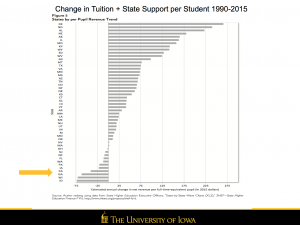
In Iowa, we’re fifth from the bottom, and we’re on the other side. We’ve been deappropriated, and we have not been able to get our tuition up to recover, at least that. And I think there’s a fairly good recognition of this problem, because at the end of the day, not one year but over a 25-year period, we’re competing in terms of quality, and programs, and support systems for our students, and faculty salaries and dorms, all the rest, against these other institutions. So I think there’s now a recognition of what’s been happening over a long period of time. Now having said that, I think there’s still a cat-and-mouse game going on between the state and the Board of Regents as to, “OK, we’ll see what you do, and then we’ll figure out what we should do.” And who goes first in all of that? We’ll see how this plays out.
But I think the other thing that’s happened is when I took this job three years ago, there was a fair degree of conversation about all three institutions being exactly the same, and they had the same admissions policy, they had the same tuition, and I think there’s now a recognition that they’re very different institutions, in a lot of different ways. We have law, medicine. Iowa State has agriculture, engineering more than we have, as well as animal sciences. UNI does not even have the research focus that ISU and we have, so they’re very different institutions, and I think there’s now a recognition that treating them the same in terms of admissions and appropriations is a very dangerous place. So those are all really good. What that means implied in your question is what’s going to happen to tuition, and what’s going to happen to state appropriations; you know as much as I do.
DI: The regents’ report on retention earlier this year showed that for the entering class of 2009, our six-year graduation rate was 72 percent — 10 percent lower than the 10 peer institutions listed in that report. With this coming summer being the final chance for students to use the Summer Hawk Grant, we were wondering what that might mean for retention rates.
Harreld: I don’t want to dispute your numbers; let me tell you relative to our peers, and our peers are defined by the way the regents define our peers. So we have six of the Big Ten schools and we have Texas and North Carolina, UCLA, and I always leave out Arizona, so those 10 schools. We have about a 12-point gap between our retention rate, graduation rates, we can give you the exact data over their current levels. So we have a gap, we’re underneath, there’s no question about that. And if that’s what you’re citing, and I should say, did you say six-year graduation rates? We don’t use six-year, and I was going to tell you why. We think four years is the appropriate level. We benchmark against four.
If we get sloppy and start using six years as the relevant mark, and we get comfortable with that, we’ve just added a substantial amount of financial obligation to the families and students. If you want to deal with student debt, target four years, not six, because that will give you a 50 percent impact real quickly in student debt. So we use at the university, we’ve all agreed to use a four-year rate. If you look at four, we have a gap.
What’s the issue? The issue is a whole bunch of programs we do not have in place, the mentoring, the tutoring, the LLCs, and dorms. You have North Carolina that gets almost $260 million more per year, with 5,000 fewer students than we have, their support systems are a lot better. So we’ve been putting a lot of emphasis on this. When you get the Summer Hawk, we did that four years ago. We haven’t had a moment of impact in Summer Hawk graduation rates. We don’t see the correlation. So we actually think that the money can be used better. So we’ve decided that we’re not going to tolerate programs that don’t move the student success set of metrics that we’re focused on, and we’re going to use the money in other places. That’s what’s happening. Same thing with some of the legacy scholarships that you mentioned. They’re going to families that don’t have the financial need, or students that don’t merit it. That’s not a productive use of our resources.
DI: Now that the 2020 initiative is further along and that committee and other administrators have had time to think about what that will mean for the university, how do you see the UI reprioritizing in order to shift resources to new opportunities?
RELATED: UI striving for perfect foresight in 2020
Harreld: Well, we finished a strategic plan, and said there were three critical priorities: student success, our research component, and our engagement across the state, and largely engagement is economic development and impact we’re having on the broader state and the region. We trying to make sure every nickel we have is up to those three. The 2020 project isn’t a fiscal issue in my mind, it’s asking what’s the appropriate structural set of issues that will enable what structure do we need to focus on those three initiatives. It’s been many decades since we’ve actually revisited structure.
In the meantime, Minnesota is taking a look at its academic structure. I was at Harvard during a period of time they were taking a look at their arts and sciences and deciding to actually pull some of that apart. Rutgers has gone through a similar process twice during that time period. There’s interesting questions. We’re teaching math in numerous places, I know engineering math is different than the statistical math, so maybe there’s good reason for that. We’re teaching biology and organic chemistry in numerous places, and they’re all complex on one side of the river and other parts, and maybe there’s good reason for that, but what we are doing is going through and saying is there a logical consistency and existing structure to enable a strategic plan? I think it’s an important exercise, and I think it’s about halfway through, and I can’t predict where it’s going to come out at this stage.
DI: In light of the sexual assault and harassment claims in recent national news, how have those allegations informed the university’s approach to sexual assault?
Harreld: I think we had an active conversation before all this. I think all of us in the country are pretty surprised with what’s been happening. I think we have an increased sensitivity, and I think it’s all good. I think it’s all healthy. If anything, maybe it’s made us on campus more aware. This is a long-term journey for our campus. We keep looking for what’s the one answer, and I think there are numerous answers to this. We will continue to stay focused on it. Some universities are doing a survey every four years. We’ve decided to do it every other year, and I think for pretty good reasons. If you do it every four years, you don’t see results or improvement or regression in the same cohort. So we’re at least trying to understand what the impact is.
We just finished the survey a few weeks ago, it’s closed, but from what I saw, we had double the percentage of people who took the survey. Two years ago, we had 9 percent, and I think we’re going to be in the 20s this year, which is great because we’re getting more feedback … We’ve trained people on how to create safe zones for the LGBT community. We’ve got training programs in place. If you’re a faculty member, and you want to be trained on how to use what pronouns and how to deal with sensitive issues in that arena. We’ve been training incoming students and others on sexual-assault set of issues, and one thing I’ve heard is we should more formalize that and create some sort of vocation and maybe identify people if you want to talk to somebody, and those are good ideas. We will just keep doing them.
This is a continual dialogue, and we will never be able to do enough. The national piece is just unfortunate that we have all these particular men of power who misused their power. I find these conversations of, “Oh, these are just allegations.” Eh, OK, we’re not going to take every one of these to the court of law, but if it smells like something, it probably is something. And maybe that has helped us have a deeper, richer conversation.
DI: There’s been a lot happening at the federal level with higher education, between the Higher Education Act reauthorization discussions and the tax bill and what implications that has for universities. How have you been responding to all that?
Harreld: Hopefully, as extremely active. I’ve written a lot of letters, I’ve had a lot of telephone conversations with the federal as well as the state level, and then I’ve written, I was in Washington, D.C., two, maybe three weeks ago now for a couple of days on Capitol Hill, meeting with our Iowa congressional delegation individually to talk about concerns. And I think it’s getting to be, there’s still going to be an impact, there are still things we don’t like, there’s still a bias in this society questioning the value of public higher education and defunding going on, we’ve had a little of that conversation.
There’s particularly in the public in the Republican Party, the Gallup Polls or maybe it was Pew, somebody recently this summer, well over half of the people who identify as Republicans actually question the value of higher education. That’s really troubling, and we’re doing a lot to make sure people understand my long-term point of view on that and why I think public research institutions like ours for 150, 170 years really critical to our society. And then so at one level working at a macro, what’s our story, why are we important, why is it important that we educate, and not for a specific job. I don’t think we train people, there are some students who come here and say, “I want to be X,” and if you’ve got a passion, go for it, but most of us, me included, have had multiple jobs in our careers, I think you will likely have numerous career paths, and they will shift and change.
And so how do you prepare students to deal with not a job but a series of jobs and a series of learning experiences, so how do we teach ourselves how to learn, or how to teach ourselves, and I think that’s what we do here. And I think it’s very different from a vocational, train me to do X, and trying to get that story out. And on the other end of that, I’m trying to spend a fair amount of my time talking about graduate-student taxation of their tuition relief, or endowment taxation, or the whole set of specific issues. I think by and large, what came out in the House version of the tax bill was quite problematic. The Senate version is much better. Now they’re going to go through a reconciliation process. I think the people that I’ve talked to saying by and large [think] the Senate version will largely prevail here. We’ll see, we’ll see.
DI: With the formation of the Center for Advancement this semester, what is your hope for that and how will that affect alumni engagement with students here?
RELATED: UI Foundation and Alumni Association move forward with merger
Harreld: Yeah, in fact I’m going to be with a group of them this afternoon talking about some of the next iteration of some new opportunities, but you know, we’ve had an Alumni Association for a long, long period of time. We’ve had a foundation for a long period of time, in fact the Alumni Association is almost twice as old as the foundation.
But as I got here and watched them working, they seemed to, they were still both representing the university, but they ran slightly different messages, they were on slightly different calendars, and I would go through and talk to people, alumni in particular, and they were confused as to who was who and what was the role of each of those, so I just said I think we’d be better off if we just had one common plan, one common database of our alumni, one view of their giving and their interests, one calendar, and we were integrated, and by the way, it was all around the programmatic consistency, quality, and not once was there any issue about, oh, we can save money. So it was just effectiveness.
A group, a committee, we formed a committee to take a look at it. They wrote a report, and I just kind of circled it, and you can see over and over again the issue of consistency and integration in this report, even though they didn’t recommend that they integrate, they were actually saying, “Leave them together, but we have to collaborate a lot more.” Collaboration was a word that kept coming up over and over again, and I finally said to myself on a weekend as I started really thinking about this, you know, the structure needs to follow strategy. The strategy is to be much more collaborative. It’s like the 2020, we’ve got three key things, our structure needs to show student success, research, and engagement.
If we’re trying to be more collaborative, then structure could really enable that in a major way, so I got myself really convinced it was the right thing to do. We’ve now integrated them, we now have the Center for Advancement. I’m still learning how not to talk about the foundation and not talk about the Alumni Association, it’s tricky, but we put them together, and what we’re seeing is when we go to locations like in D.C., we had an event. We didn’t have a foundation event and an Alumni Association event, we actually had the University of Iowa event. We had a similar event a few weeks ago in St. Louis, and it went over a day and a half as I recall, and there were a set of different activities that were seamless. We had Jim Leach, who’s the interim director of marketing who comes in and starts talking to probably the older generation about our art, where we’re going with the Art Museum. There was an event at the zoo, was probably the younger generation, the kids and the like, and they came together for a social event. So to me, it’s much more natural.
We’re now, today, we’re talking about how to tighten the integration in each of our colleges, because each of our colleges have outreach activities, and they all need to be part of the same program. I think we’re one university, as I look at our strategic plan it says the more collaborative we are, we will still have homerooms, we will still have colleges, we will still have St. Louis alumni, but as we work together and the more consistent we are in how we position ourselves and talk about our issues, I think the more powerful we are, so I think that’s what we’re trying to do. The next step is to involve the colleges in the same piece. And not to take away, not to centralize activities, but actually to standardize activities and get consistency, because then our message gets that much more powerful. So that’s what we’re trying to get done.
I get the comments from other universities that are really watching us because I went around and talked to everybody about whether we should do this or not, and I consistently heard, “It’s a great idea, but you can’t do it because this group won’t play nice. Politically, you can’t do it.”
But I think we’re good enough to be able to do the right thing the right way and I think we’ve gotten there. Now people are looking and saying, “How did you do that? And it only took you a few months?” Well I think it’s because Midwesterners, by and large, particularly Iowans, like working together, they like teams.



